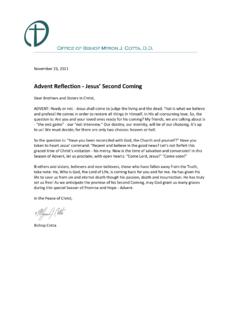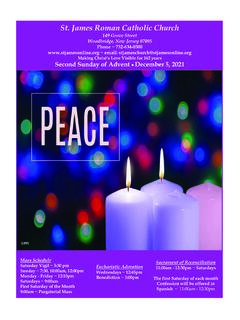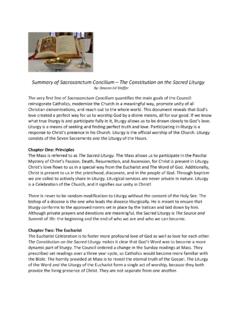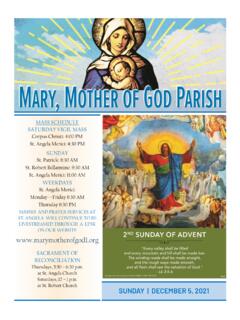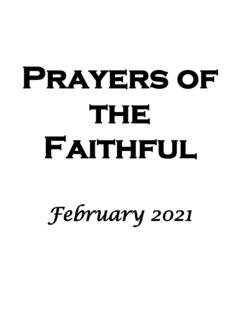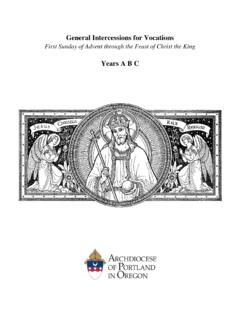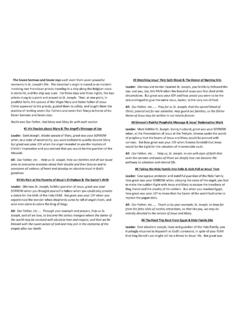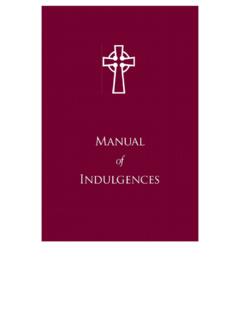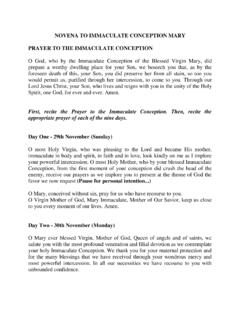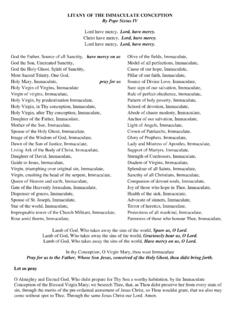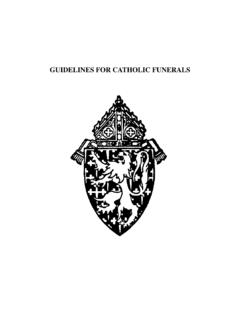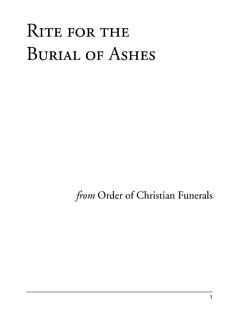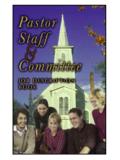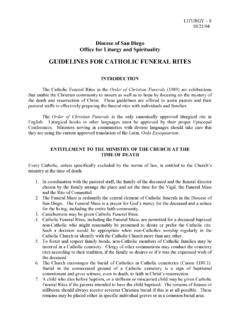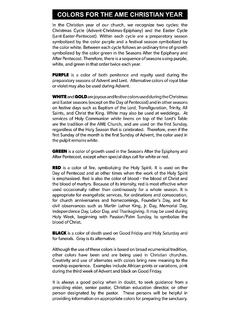Transcription of The Order for Funerals
1 The Order for Funerals for use by the Ordinariates erected under the auspices of the Apostolic Constitution Anglicanorum c tibus 2 The Order for Funerals for use by the Ordinariates erected under the auspices of the Apostolic Constitution Anglicanorum c tibus Introduction 1. In the funeral rites the Church celebrates the Paschal mystery of Christ. Those who in Baptism have become one with the dead and risen Christ, at the end of their sacramental life,1 will pass with him from death to life, to be purified in soul and welcomed into the fellowship of the saints in heaven. They look forward in blessed hope to his second coming and the bodily resurrection of the dead. The Church therefore celebrates the Eucharistic sacrifice of Christ s Passover for the dead, and offers prayers and petitions for them. In the communion of all Christ s members, the prayers which bring spiritual help to some may bring to others a consoling 2.
2 In celebrating the funeral rites of their brothers and sisters, Christians proclaim their Paschal faith in fidelity to the Gospel and offer in the funeral Mass the sacrifice of the death and resurrection of Christ so that the dead may be purified of their sins and admitted to the Paschal fullness of the Kingdom. The Order for Funerals for use by the Ordinariates erected under the auspices of the Apostolic Constitution Anglicanorum c tibus gives expression to the Anglican liturgical patrimony which has nourished many in their faith in the resurrection of Jesus Christ from the dead and the hope of eternal glory. Its use is therefore restricted to those clergy and faithful who belong to one of the Personal Ordinariates established under the Apostolic Constitution Anglicanorum c 3. In cases of pastoral necessity or in the absence of a priest or deacon incardinated in an Ordinariate, any priest or deacon incardinated in a Diocese or in an Institute of Consecrated Life or Society of Apostolic Life may celebrate the funeral liturgy according to The Order for Funerals for members of the Ordinariate who request 4.
3 The Order for Funerals has been arranged in three sections: The Order for a Vigil for the Deceased, The Order for a funeral Mass and The Order for Funerals Outside Mass. 5. The Church accompanies her children throughout their earthly pilgrimage and especially at journey s end. She offers to the Father, in Christ, this child of his grace, and she commits to the earth, in hope, the seed of the body that will rise in glory. This offering is fully celebrated in the Eucharistic sacrifice; the blessings before and after Mass are 1 Cf. Catechism of the Catholic Church, no. 1682. 2 Cf. The Roman Ritual, Order of christian Funerals , no. 1. 3 Cf. Pope Benedict XVI, Apostolic Constitution Anglicanorum c tibus, no. III. 4 Cf. Congregation for the Doctrine of the Faith, Complementary Norms to the Apostolic Constitution Anglicanorum coetibus, no. 6 2. As the Eucharist is the heart of the Paschal reality of christian death, the funeral of a baptized person is normally celebrated within the context of a funeral Mass.
4 6. After the funeral Mass, the rite of Absolution at the Bier is celebrated. This rite is not to be understood as a purification of the dead which is effected rather by the Eucharistic sacrifice but as the last farewell with which the christian community honours one of its members before the body is committed to the earth. This rite is accompanied by the sprinkling with holy water and the censing. The sprinkling with holy water, which recalls the person s entrance into eternal life through Baptism, and the incensation, which honours the body of the deceased as a temple of the Holy Spirit, may also be considered as signs of farewell. 7. The celebration of a funeral Mass is permitted on any day except Solemnities that are Holydays of Obligation, Thursday of Holy Week (Holy Thursday), the Paschal Triduum, and the Sundays of Advent, Lent, and Easter. 8. In celebrations for the dead, whether the funeral service itself or during vigils, prayers at the grave, or any other celebration, emphasis should be given to the readings from Sacred Scripture.
5 These proclaim the Paschal mystery, support the hope of reunion in the Kingdom of heaven, teach respect for the dead, and encourage the witness of christian living. Likewise, The Order for Funerals suggests an ample use of psalmody which expresses grief and strengthens genuine hope in the resurrection of the dead in Christ Jesus. 9. According to the ancient christian practice, the Church s preference is for the custom of burying the dead in a grave or tomb, as the Lord himself willed to be buried. christian funeral rites are permitted for those who choose to have their bodies cremated, unless it is shown that they have acted for reasons contrary to christian In cases of cremation, the ashes of the deceased are always to be buried, or properly placed in a niche of a mausoleum. 10. For the celebration of the funeral rites when the body is cremated, reference should be made to the liturgical norms on The Celebration of the funeral 11.
6 The ordinary minister (celebrant) of the funeral service is the priest. For Funerals which take place outside of Mass, a priest or deacon may preside. In the absence of an ordained minister, a lay person may lead the community in some of the prayers and readings of The Order for Funerals , particularly at a vigil service. In this case, the liturgical greeting The Lord be with you is not used. 12. The celebrant, considering the pastoral circumstances and the wishes of the family and parish community, should make free use of the choices afforded in the rite. 5 Catechism of the Catholic Church, no. 1683. 6 Cf. CIC, Can. 1176, 3. 7 The Roman Ritual, Order of christian Funerals , Appendix 2: Cremation. 413. The bier is set down in the church so that the feet of the departed, except in the case of a priest, are toward the altar. The Paschal Candle may be lit and positioned near the bier.
7 According to local custom, candles may be lit around the body. 14. The Vigil for the Deceased or an extended period of prayer before a funeral Mass may be accompanied by the appropriate canonical hour from the Office for the Dead. 15. Either black or violet vestments may be worn during a funeral Mass. In the case of a funeral of a child who died before attaining the age of reason, white vestments are used. 16. The use of Holy Ghost instead of Holy Spirit is permitted according to local custom. 17. For any circumstances that are not covered in this Rite, reference should be made to the Roman Ritual, Order of christian Funerals . 5 The Order for a Vigil for the Deceased with Reception at the Church Introduction Sprinkling the coffin with holy water at the entrance of the church, the celebrant says: With this water we call to mind N s baptism. As Christ went through the deep waters of death for us, so may he bring N to the fullness of resurrection and life with all the redeemed.
8 The celebrant (and choir) preceding the coffin into the church say or sing one or more of the following Sentences; together with one or more of the Penitential Psalms (6, 32, 38, 51, 102, 130, 143) if need so require. I am the resurrection and the life, saith the Lord: he that believeth in me, though he were dead, yet shall he live: and whosoever liveth and believeth in me shall never die. Jn 11:25, 26 I know that my Redeemer liveth, and that he shall stand up at the last upon the earth: whom I shall see for myself, and mine eyes shall behold, and not another. cf. Job 19:25 27 We brought nothing into this world, and it is certain we can carry nothing out. The Lord gave, and the Lord hath taken away; blessed be the name of the Lord. 1 Tim 6:7; Job 1:21 Remember not the sins and offences of my youth: but according to thy mercy think thou upon me, O Lord, for thy goodness. Ps 25:6 The eternal God is thy refuge, and underneath are the everlasting arms.
9 Deut 33:27 6 Neither death, nor life, nor Angels, nor principalities, nor powers, nor things present, nor things to come, nor height, nor depth, nor any other creature, shall be able to separate us from the love of God, which is in Christ Jesus our Lord. Rom 8:38, 39 Whether we live, we live unto the Lord; and whether we die, we die unto the Lord: whether we live therefore, or die, we are the Lord s. For to this end Christ both died, and rose, and revived, that he might be Lord both of the dead and living. Rom 14:8, 9 Blessed are they that mourn: for they shall be comforted. Mt 5:4 Let not your heart be troubled: ye believe in God, believe also in me. In my Father s house are many mansions. Jn 14:1 Liturgy of the Word If it is the custom in the local community, the pall is then placed on the coffin by family members, friends, or the celebrant A crucifix or some symbol of the christian life may be carried in procession, then placed on the coffin.
10 The celebrant greets those present. The grace and peace of God our Father and the Lord Jesus Christ be with you. People And with thy spirit. Collect Let us pray. The celebrant says one of the following prayers. 7 Before the funeral of an adult: O God, whose mercies cannot be numbered, accept our prayers on behalf of thy servant N, and grant him/her an entrance into the land of light and joy, in the fellowship of thy saints; through Jesus Christ thy Son our Lord, who liveth and reigneth with thee in the unity of the Holy Spirit, one God, now and for ever. Amen. Before the funeral of a child: O God, whose beloved Son did take little children unto his arms and bless them, give us grace, we beseech thee, to entrust this child N to thy never failing care and love, and bring us all to thy heavenly kingdom: through the same thy Son Jesus Christ our Lord, who liveth and reigneth with thee in the unity of the Holy Spirit, one God, now and for ever.
